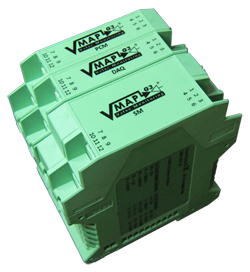
Valve Condition and Performance Monitoring Enters a New Era




Proprietary mini server and router package that funnels up to 16 DAU data streams into 1 for temporary storage on the SPU hard drive. The SPU provides the intrinsic safety protection for the data and power circuits between the safe area and DAU in the field environment (certified for Zone 0). The SPU transmits data associated with valve cycles and other events to the main VMAP® G3 host application for further analysis and permanent storage.
The DAUs, which are located inside the junction boxes, continuously log and stream the actuator pressure and strain at 40 readings/second and AE readings at 1 reading/second regardless of whether the valve is operating or not. The DAU is comprised of 3 modules: The Sensor Module, the Data Acquisition Module and the Power and Communications Module. The data is stored on the server where it is subject to data reduction to optimise the storage. The DAU buffer memory is used as a short term back up in the event of communication or power outage.
Acoustic Emission (AE) is a term normally associated with high frequency sounds or vibrations that are emitted from materials or structures under load and potentially approaching failure. The high frequency sounds or vibrations are the stress waves produced by the sudden internal redistribution of stress within the materials caused by changes in the internal structure of the material. Crack growth due to fatigue, hydrogen embrittlement, stress corrosion, and creep can be detected and located by the use of AE technology. AE technology is also widely employed in the non-destructive testing for structural integrity of materials and structures made from composite materials. Fiber breakage, matrix cracking, and delamination are three mechanisms that can produce AE signals when stress is applied to the material or structure.
In valve monitoring applications, Acoustic Emissions (AE) rely on the noise generated by a turbulent leak to enable leak detection and quantification. Score’s Midas Meter® and Midas® Sensor use the 60 kHz to 600 kHz range. This very high frequency range helps eliminate background noise from the plant and to localise the source of the noise due to the high attenuation at these frequencies.
An AE sensor can be mounted on the valve body, to detect if there is through seat leakage. In order to provide additional confirmation that the valve is generating the noise and not an adjacent leaking valve Acoustic Emissions sensors are mounted on the piping up and downstream, typically 1 to 2 meters from the valve. By comparing the readings the system can determine with more certainty that it is that valve that is leaking.
Strain measurement is used to measure the force or torque required to operate the valve throughout its stroke. Changes in the force or torque are key indicators in the performance of the valve and the progression of degradation mechanisms. Two identical sets of strain gauges are mounted directly on to the mounting stool between the valve and actuator; one is the Active set the other a Spare set.
The monitoring of strain gives the torque or force that is applied to the valve during operation. This measure gives the following benefits especially when combined with actuator pressure monitoring:
Typical outputs of strain converted to valve torque v time can be shown for full and partial closure operations. These can be compared to previous operations and benchmarks. From these charts the key data points are established for trending, such as effects of seat and stem friction.
The pressure transmitter is mounted directly into fluid supply line to the actuator cylinder. Actuator pressure is recorded on both single and double acting actuators.
Typical outputs of actuator pressure v time can be shown for full and partial closure operations. These outputs can be compared to previous operations and benchmarks. From these charts the key data points are established for trending and determining the actuator and valve performance.
A digital signal is sent to the solenoid from the client’s operating system in order to perform a valve operation. V-MAP® monitors this digital signal constantly to ensure that all valve operations are recorded and analysed.
The limit switch and position indicator are used to show the valve’s position and are monitored by the client’s operating system. V-MAP® interprets the limit switch signal from the client’s system to keep track of which position the valve is in.
Intelligent Valve Controller integrates a 4-20mA positioner, inductive switches and position indicator to provide valve position feedback with a Partial Stroke Test controller. It contains electronics that can perform various operations such as partial and full stroke on demand.